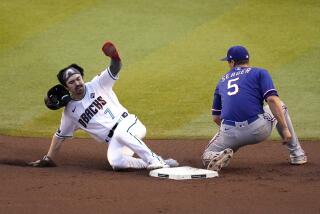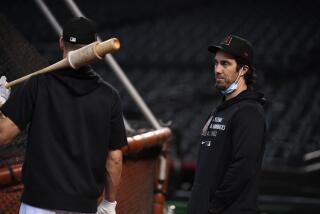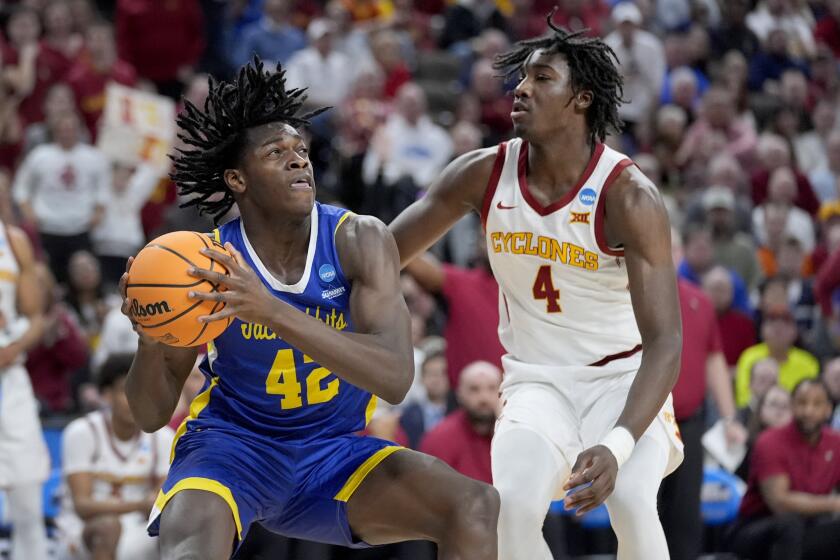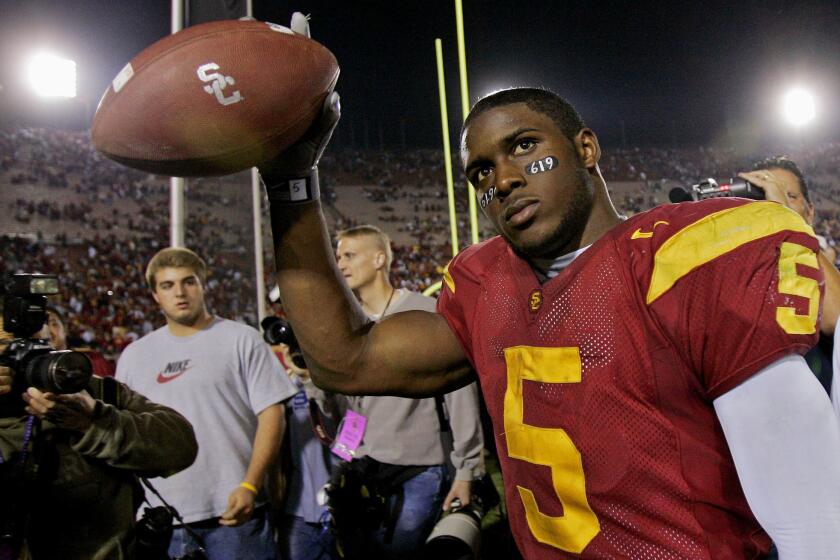Angels in the outfield could be among best
It’s a little too soon to anoint Torii Hunter, Vernon Wells and Peter Bourjos as one of the best defensive outfields in baseball history, as has been suggested this spring.
The Angels might not even have the best outfield in their division.
The Seattle Mariners have 10-time Gold Glove Award winner Ichiro Suzuki in right field, 2010 Gold Glove winner Franklin Gutierrez in center and a solid tandem of Michael Saunders and Milton Bradley in left.
And the Texas Rangers have a thriving threesome with Julio Borbon in center, Josh Hamilton in left and Nelson Cruz in right.
But make no mistake: This should be a summer of glove in the Angels outfield, which has nine-time Gold Glove winner Hunter in right and three-time winner Wells in left flanking Bourjos, a speedy and acrobatic center fielder.
Angels reliever Hisanori Takahashi keeps an eye on homeland
“Defensively, this could be the best outfield in the game,” said Hunter, who moved from center field to right in August to make room for Bourjos.
“You look at the speed of Bourjos, the athletic ability of me and Vernon. I’m not trying to be cocky, but Vernon is athletic. I’m 35, so it seems like I’m older, but I can play.
“The instincts of playing the game, the arm strength … looking at the total package, not many teams have three outfielders like us.”
Nor did many teams have two corner outfielders like the Angels had in 2010.
With the heavy-legged Juan Rivera in left and the not-so-nimble Bobby Abreu in right, Hunter chased balls so far into the gaps he wasn’t sure his legs would hold up for a whole season.
In early August, Hunter gave up the center-field position he took so much pride in playing and Bourjos was promoted from triple A.
Bourjos hit .204 in 51 games but had an effect on defense, saving 15 runs in only two months, according to fangraphs.com.
That prompted the Angels to make Hunter’s switch permanent and pencil in Wells — another center fielder — for left after acquiring him from the Toronto Blue Jays in January.
“It doesn’t happen very often where guys are asked to move from their primary position to help the bigger picture,” Manager Mike Scioscia said. “But Torii is here for one thing, to win, and if that means we ask him to play shortstop, he’d play shortstop.
“And we had enough information on Vernon [before the trade] that we knew it wouldn’t be an issue. These guys have the versatility to do it.”
According to advanced defensive metrics, which assign numerical values to components such as range, arm strength and accuracy, Hunter and Wells, 32, have declined as center fielders.
But Hunter made a smooth transition to right field last season, and Scioscia believes Wells has the skills — good speed and instincts, strong arm — to be an outstanding left fielder.
“As athletic as Vernon is, with as much talent as he has, it should be a position he settles into,” Scioscia said. “We’re excited to start putting those pieces together.”
The key piece is Bourjos, a 24-year-old who returned to action Tuesday after being sidelined for three days because of a sore right hip. He has limited big league experience but seemingly unlimited defensive upside, as he showed in Angel Stadium on Aug. 13.
In the fourth inning of the Angels’ 3-0 loss to the Blue Jays, Bourjos sprinted into shallow left-center field to make a diving catch of Aaron Hill’s sacrifice fly.
In the fifth, Bourjos, playing shallow against light-hitting Yunel Escobar, got an excellent jump on a liner to deep center and made an over-the-shoulder, running catch at the warning track.
In the ninth, with a runner on first, Bourjos raced to the gap in left center and made a diving catch of Jose Bautista’s laser near the warning track to save a run.
A week later, in the Angels’ 9-3 win over Minnesota, Bourjos showed off his arm, throwing out Delmon Young at the plate.
“I can still play center field — I’m not declining — but Peter can be one of the best center fielders in the game,” Hunter said. “His speed is game-changing. Right now, if he runs a bad route his speed can make up for it.”
There is room for improvement, too.
“He still has a lot to learn,” Hunter said. “But the more he plays, the more we help him, the more comfortable he’ll be.”
That speed in center and Gold Glove experience at the corners will be a welcome sight for Angels ace Jered Weaver, who quietly chafed at the outfield defense last season.
“This is one of the best outfields I’ve seen,” Weaver said. “Me being a fly-ball pitcher, it’s going to be fun to watch.”
Hunter might have to resist an urge to be a spectator from right field.
“I’ll run my 10-yard routes,” he said. “It’s boring, but it’s easy. I’ve got to look at the long term. This could prolong my career.”
The speed, athletic ability and range should result in more fly balls being caught, more balls to the gaps cut off to prevent singles from becoming doubles, and better run containment.
“The team aspect of defense is not so much their ability to make the spectacular catch and rob home runs,” Scioscia said. “It’s more of a grass-roots thing, controlling the running game, stopping the first-to-thirds, containing guys scoring from second as much as they can. That’s what we’re excited about as much as anything.”
More to Read
Get our high school sports newsletter
Prep Rally is devoted to the SoCal high school sports experience, bringing you scores, stories and a behind-the-scenes look at what makes prep sports so popular.
You may occasionally receive promotional content from the Los Angeles Times.







